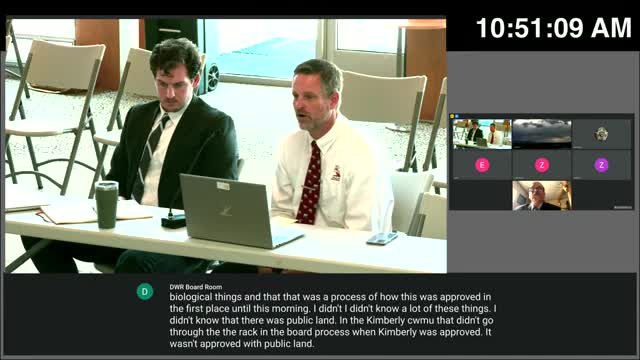Controversy erupts over public land in private hunting area
August 22, 2024 | Wildlife Resources, Utah Environment, State Agencies, Organizations, Utah Executive Branch, Utah
This article was created by AI summarizing key points discussed. AI makes mistakes, so for full details and context, please refer to the video of the full meeting. Please report any errors so we can fix them. Report an error »

In a recent government meeting, significant concerns were raised regarding the management and classification of land within a Cooperative Wildlife Management Unit (CWMU). A coordinator expressed frustration over the inclusion of public lands in the CWMU without proper disclosure, highlighting that this oversight could undermine the credibility of the management process. The coordinator emphasized that the presence of public land should have been communicated to the CWMU advisory committee and the board, as it is a critical factor in the approval process.
The discussion revealed confusion over the acreage calculations, with discrepancies noted between the reported contiguous and non-contiguous land. The coordinator pointed out that the application indicated zero public acres, which raised alarms about transparency and compliance with established guidelines. The implications of this oversight could lead to complications in hunting regulations and the allocation of tags to the public.
Participants in the meeting debated the accuracy of the land assessments, with one individual asserting that their application did not intentionally misrepresent the land's status. They clarified that while there are small parcels of public land within the private boundaries, these were not included in their calculations for private acreage. The conversation also touched on the historical context of land ownership and grazing rights, underscoring the complexities involved in managing these resources.
As the meeting progressed, concerns were voiced about the potential biological impacts of land management decisions, particularly regarding elk populations. The coordinator noted that requests for significant elk harvests could face resistance from landowners, complicating wildlife management efforts.
Overall, the meeting highlighted the need for clearer communication and adherence to regulations in land management practices, particularly when public lands are involved. The discussions underscored the importance of transparency in the application process to maintain trust and effectiveness in wildlife management initiatives.
The discussion revealed confusion over the acreage calculations, with discrepancies noted between the reported contiguous and non-contiguous land. The coordinator pointed out that the application indicated zero public acres, which raised alarms about transparency and compliance with established guidelines. The implications of this oversight could lead to complications in hunting regulations and the allocation of tags to the public.
Participants in the meeting debated the accuracy of the land assessments, with one individual asserting that their application did not intentionally misrepresent the land's status. They clarified that while there are small parcels of public land within the private boundaries, these were not included in their calculations for private acreage. The conversation also touched on the historical context of land ownership and grazing rights, underscoring the complexities involved in managing these resources.
As the meeting progressed, concerns were voiced about the potential biological impacts of land management decisions, particularly regarding elk populations. The coordinator noted that requests for significant elk harvests could face resistance from landowners, complicating wildlife management efforts.
Overall, the meeting highlighted the need for clearer communication and adherence to regulations in land management practices, particularly when public lands are involved. The discussions underscored the importance of transparency in the application process to maintain trust and effectiveness in wildlife management initiatives.
View full meeting
This article is based on a recent meeting—watch the full video and explore the complete transcript for deeper insights into the discussion.
View full meeting

